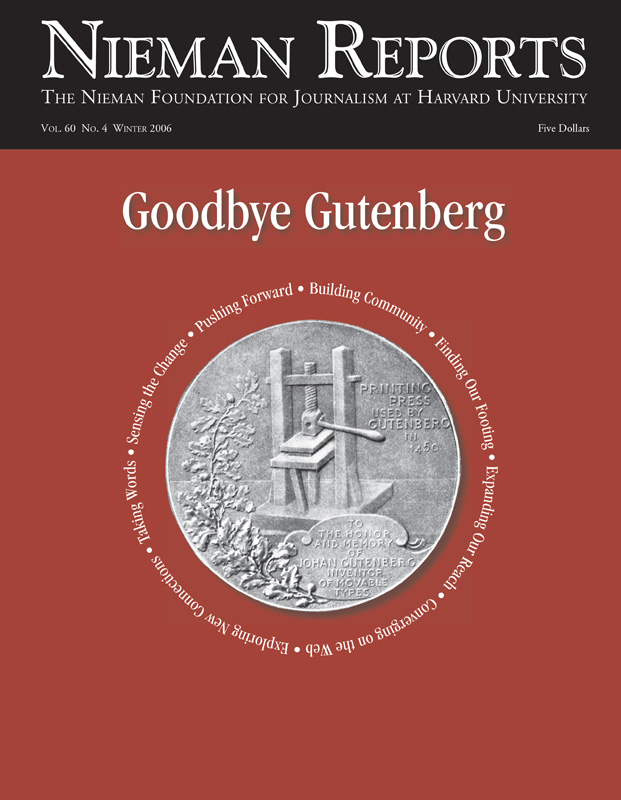Most leading-edge thinkers long ago accepted the digital revolution’s transforming reality and are now engaged in what amounts to the news industry’s Quest for the Holy Grail: the development of a business model that will pay for quality journalism in a digital world.
Like those brave knights of olden days, they are quickly learning that this Holy Grail is not easy to find. The search is not to determine whether online operations can drive new revenue and turn a profit; they’re doing that already, in a modest fashion. Instead, the quest is to find a robust business model that can support newsgathering enterprises during the bumpy transition from print to online and then whether that financial engine can fuel and sustain a complete digital transformation so that journalism exists at the other end.
Perhaps the best way to understand where newspapers are—and where they need to go—is to follow the money.
Ponder for a minute the predicament of a hypothetical daily newspaper, the Digiton Daily News, and consider a few back-of-the-envelope calculations. The Daily News has long been a profitable midsized regional newspaper, with daily circulation of about 150,000. Its annual revenues hover around $100 million, with about five million dollars coming from its Web site. While circulation and print ad sales are slipping, online revenues continue to surge, increasing by some 40 percent over last year, a blistering pace of growth in an otherwise stagnating business.
But is that online growth alone enough to save the journalistic enterprise? Heck, right now that revenue doesn’t even cover the cost of the newsroom, which runs about $12 million a year. So even if online revenues continue to grow at the explosive rate of 40 percent each year—and that’s a daring leap of faith—it will be more than three years down the road before there’s enough revenue to cover only the cost of running the news operation. And that’s to say nothing of supporting any other departments, like advertising or circulation, or even about generating a profit margin (and most newspapers, as we know, have long been accustomed to margins approaching 30 percent).
Put another way, and assuming a continuing rosy (or even delusional) scenario of 40 percent annual growth, it would take the Daily News almost a decade to generate online the same amount of revenue it enjoys today. But by the time those 10 years pass, the world will have become so radically reshaped that today’s assumptions will no longer prevail. It would be foolish to bet all your chips on this scenario.
In short, it doesn’t look easy to get from here to there, at least not in a straight line. So how should newspaper companies think strategically about their survival, and what should they do to build a robust business model?
RELATED WEB LINK
About Newspaper Next
–www.newspapernext.orgSome big players have recently joined the quest for the Holy Grail in a big way. The Los Angeles Times has dispatched a team of investigative reporters as part of its "Spring Street Project" to figure out its future. One former Knight Ridder executive has called for creation of a newspaper Switzerland, an ostensibly "neutral" group to organize the balkanized industry around an online future. A two million dollar industry white paper—called "Newspaper Next"—has put forth a blueprint of sorts. And most every other newspaper is desperately dashing forward in some fashion to figure out its future.
Principles for the Transition
No one has found the answer, and that’s because there is no single correct answer. There are, however, some overarching principles that will be important guides as we shape our future:
Adopt the new thinking: The old newspaper model is on life support, and we need to recognize and ride the meta-trends playing out in communication. Newspapers are no longer an all-powerful gatekeeper for news and information; anybody with a computer can be a publisher. News has become a multilayered conversation, not a monologue. Power resides in the individual, not a central authority, and newspapers ignore the power of the individual and the network at our peril.
Put the Web first: This might be the most difficult transformation in our mindset, but we should go ahead and flip our world on its head. Think of the Web first and print second. Imagine what might happen when we invert the traditional paradigm: It opens up a wide range of possibilities, many of which we cannot see from where we now look.
Embrace the smorgasbord: Print will remain vital during the transition, but it will need to change and adapt. Newspapers need to reenergize their print side by inventing an array of niche products to better target readers and serve advertisers. Smart ways must be found to keep the core newspaper strong.
Don’t be afraid to experiment; be courageous about change: Some new ideas will work and some won’t. That’s OK. Try new ideas, like ancillary Web sites or niche publications. Evaluate their success. If they work, keep them going; if they don’t, kill them and try something else.
Don’t milk the cash cow dry: One predominant sentiment in the industry today is that newspapers, which are a mature business, are cash cows, and the best thing to do is to milk them for all the profits we can. But that shortsighted approach undercuts one of the best advantages newspapers have: to invest, and not simply milk, the profits by putting substantial portions of those margins into online. Just as newsrooms can become the content engine for the Web, newspaper profits, if properly marshaled, can fuel our online development, if we adopt a true investment mindset. What that means, however, is that we must intentionally embrace more reasonable profit margins and invest the difference in online ventures. That’s a bold leap, but if we think of 20 percent margins as a ceiling, and not a floor, for instance, we can buy a lot of freedom to build a strong future.
Business Possibilities
If we adopt these guiding principles to focus our long-range strategy for creating a robust business model, then a slew of opportunities will arise to drive revenue, increase profits, and build a sustainable journalistic enterprise. Here are a few of these possibilities:
Create a stable of niche publications: Find targets of opportunity—working moms, local businesses, music aficionados, pets, resort communities, lawyers, doctors—and develop business plans to meet reader and advertiser needs. These are smaller but often lucrative ways to supplement the mass-market newspaper, though sometimes online efforts may make more sense than print.
Own local? Go global: Almost every region has something special that can play on a larger stage. In our region of Virginia, for example, bluegrass music is big, and we should expand on that strength and create a Web site with tentacles reaching far beyond our circulation area. No, we haven’t yet done that one, but every newspaper should identify similar opportunities and find a way to own them.
Develop a guerrilla video operation: Newspapers have long been hesitant to embrace video, but rising broadband penetration opens the door to developing some new and powerful storytelling with online video. And this offers a way ultimately to compete with local TV stations for viewers and advertising dollars. The trick is to start small, learn by doing, engage the newsroom, and then grow.
Think crazy: Not every idea will be related to traditional news and information; in fact, many of the best ones won’t be. So look for significant audiences, and find a way to engage them online in ways that don’t smack of a newspaper. Perhaps your news organization should pursue a social-networking and employment site for the large community of health-care workers in your region, or develop a pure music site for the region’s bands and fans. Sure, it’s not journalism with a capital "J," but it’s a way to create places for audiences to gather and share information. That will meet audience needs and strengthen the business.
Own community information: The big, bad wolves that threaten newspapers are Google, Yahoo! and the next wave of online wannabees. They want to steal local audience, and they know that owning local information—from entertainment to employment to restaurants—is the way to do that. Take a crash course to gather up this information, pour it into a database, offer a dynamite search function, and become the best source of local information.
Experiment with different revenue models: Some newspapers, such as The Wall Street Journal and The New York Times, have been able to charge for content online, but most have not. There might be some opportunities to do that if you have a wildly popular sports columnist or the like. And there are other ways to find revenue beyond run-of-site advertising and online classifieds ads, including e-commerce, generating specific leads for advertisers, tightly targeted ads, search and find results. A successful mix of revenue streams is mandatory.
Build and sell a good idea: Is there an online innovation you’ve created that can be sold as a one-off product to other operations? Perhaps it’s some social-networking software, or an online video solution, or an interactive database. There are other newspapers hungry for smart solutions. You might be able to market and sell yours to them.
No doubt there are plenty of other good ideas, and these are meant only to stimulate some creative thinking. That raises a most important point. For so long, newspapers have imagined themselves as media enterprises, assembling news and information for the masses by reporting, editing, designing and publishing. But this new digital world requires us to imagine ourselves differently as we reinvent our future.
No longer are we purely media companies; we must become technology RELATED WEB LINK
The Roanoke Times
– www.roanoke.comcompanies, too, and that means we must raise our technology IQ to compete in a digitally transformed world. A big part of our success will be tied into rethinking what type of people we hire. The premium, moving forward, will rest on attracting more innovators into our midst and finding ways to give them the freedom and the backing they need to experiment and help move us into a new realm in which we can preserve the journalism and make a robust business model work.
Michael Riley, a 1995 Nieman Fellow, is editor of The Roanoke Times. The newspaper’s Web site was named the overall best midsized newspaper site by the Online News Association and Editor & Publisher, and it has won multiple national awards for its cutting-edge content and multimedia work.



